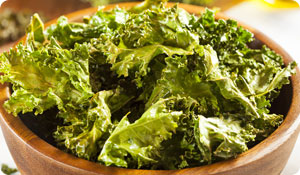
Long a staple of southern cooking, kale has exploded onto the national scene in recent years, and with good reason. This leafy green vegetable, visually similar to spinach and belonging to the same family as cabbage and collard greens, has been labeled a super food by experts.
Why is kale so praiseworthy? It offers a host of disease-preventing antioxidants, provides a boatload of vitamins, and contains plenty of fiber, among other things. It's also easy to work with, lending itself to soups, salads, sautéed dishes, and even smoothies.
What Does Kale Have to Offer?
Vitamins. Kale is rich in a number of vitamins. At the top of the list is vitamin K, which plays an essential role in clotting blood. One cup of cooked kale provides more than 13 times the recommended daily allowance (RDA) of this vitamin, far more than any other food. The same amount of kale also provides 354 percent of the RDA of Vitamin A and nearly 89 percent of the RDA of vitamin C.
Flavonoids. Researchers have been able to identify more than 45 different flavonoids—plant compounds full of antioxidants—in kale, which they believe are key to its anti-cancer properties.
Fiber. Providing 10 percent of your RDA, one cup of cooked kale offers excellent digestive support as well as satiety.
What's the Best Way to Eat Kale?
While steaming enables you to retain the maximum nutrients, there are plenty of other methods of preparation.
- Throw a handful of kale into your blender while you're making fruit smoothies for a breakfast boost.
- At lunch, layer a few leaves of kale onto your sandwich.
- Need a pre-dinner snack for the kids? Make kale chips, a guilt-free alternative to potato chips, by rinsing and drying kale leaves, spraying them with an olive-oil mist, sprinkling with salt, and baking them until crunchy. Many natural-foods stores and mainstream supermarkets now carry prepared kale chips—a great time saver for busy families.
Other ideas include:
- Egg-white omelet with kale, feta cheese, tomato, and onion
- Whole-grain pasta with kale, olive oil, parmesan cheese, and garlic
- Vegetable soup with kale
Don't limit yourself when it comes to this versatile veggie. Make kale part of your regular repertoire and you'll reap the benefits of this super food.
Alison Massey, MS, RD, reviewed this article.
Sources:
"Crazy For Kale," Academy of Nutrition and Dietetics, accessed August 7, 2013.
http://www.eatright.org/kids/tip.aspx?id=6442466654
"What's New and Beneficial About Kale," George Mateljian Foundation, accessed August 7, 2013.
http://www.whfoods.com/genpage.php?tname=foodspice&dbid=38





